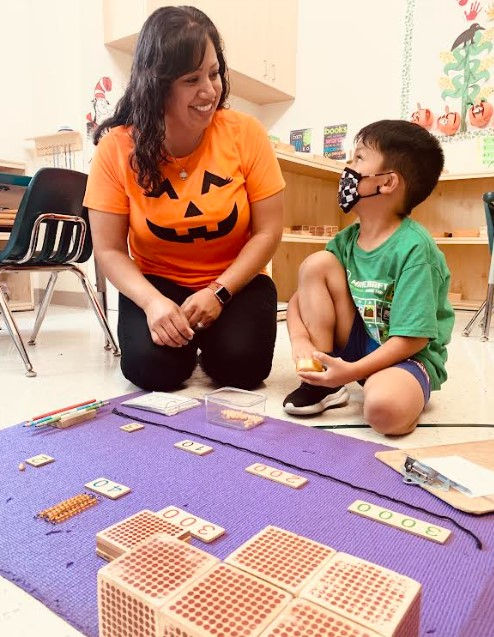Exploring Montessori Materials
- Arborland
- Oct 5, 2022
- 3 min read
Updated: Oct 10, 2022
Montessori materials are hands-on learning tools that guide children to discover key learning outcomes through practice and repetition. Each material breaks down one key concept into simple steps that children master through hands-on exploration. We selected some of the most recognizable Montessori learning materials that the primary and toddler children ages 2-6 are currently exploring in their respective classrooms.

The Pink Tower

The Pink Tower is the iconic Montessori material. Often called the ‘symbol of Montessori’, it is a recognizable sign in all Montessori environments. This material helps the child to develop visual discrimination of size in three dimensions and prepares them for mathematical concepts and geometry. It also helps the child practice control of body movement as the child brings each cube individually from the shelf to the rug and back.
Sandpaper Letters

The sandpaper letters guide the hand for writing as the child traces the letter shapes in the style and direction that they are written. While tracing, the child is asked to repeat or identify the phonetic sound of the letter. In the interaction of visual and tactile linguistic stimulation, children can learn and remember letters better.
Puzzle Maps

Creating globally minded citizens is a pillar of Montessori education. Students are taught that all things are interconnected and nothing is studied in isolation, including our world. Maps are used in every type of classroom to help students first learn about the different continents of the world, and then the countries in each continent soon after. Because this particular material is specifically proportional, children also gain an understanding of how countries fit together and their relative sizes.
Hanging Bead Stairs

The main purpose of this activity is to help develop the child's knowledge about numbers in order to associate concrete quantities with their respective single-digit numerals. The material enables the child to get a better understanding of the math facts and helps in developing the child’s logical thinking in ordering the numbers from smallest to largest.
Constructive Triangles

This Montessori material is used to show the child that all plane geometric figures can be constructed from triangles. It usually consists of a set of 5-6 boxes which contain different types of triangles used to form rectilinear or right-angled figures.
Knobbed Cylinders

Knobbed Cylinders are designed to assist children in making distinctions in their immediate environment. This material teaches the child visual discrimination of dimension. This activity also helps the child develop their pincer grip which is necessary for writing.
Spindle Box

The wooden spindles are introduced after the child has a solid understanding of the quantities 1-10 and recognizes the corresponding numeric symbols. This material makes numbers concrete and lets our little ones see how each number represents a quantity of one more than the one before it.
Spooning Activity

Montessori spooning work is a 'practical life' activity that is typically introduced in a Montessori classroom in the toddler years. This material is aimed at helping the child to master the coordination and concentration needed to interact with more difficult Montessori materials and navigate the Montessori environment. Practical life activities allow the child to master a daily life skill, which in this case is spooning related to feeding oneself.
Trinomial Cube

The Montessori Trinomial Cube is a sensorial material that consists of colored wooden blocks inside of a hinged wooden box. The cube is made up of 27 blocks – 3 cubes and 24 prisms. This material encourages the child to practice the steps to properly disassemble and build the cube, while refining dexterity and visual perception. Though its origins link to a trinomial equation, at the primary age, the children treat it as a 3D puzzle to solve.
Bank Game

Montessori Bank Game is an activity where a child is given a number using the wooden number cards and then goes to the "bank" to get the corresponding golden bead material. This material introduces the child to the concept of place value and demonstrates the value of the digits in the formed number (thousand, hundreds, tens, units).






Comments